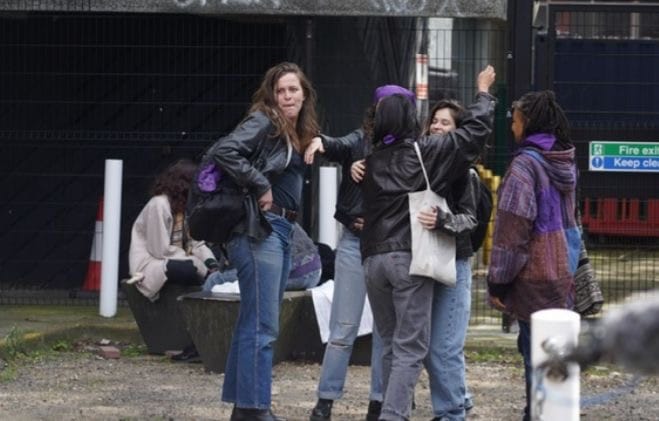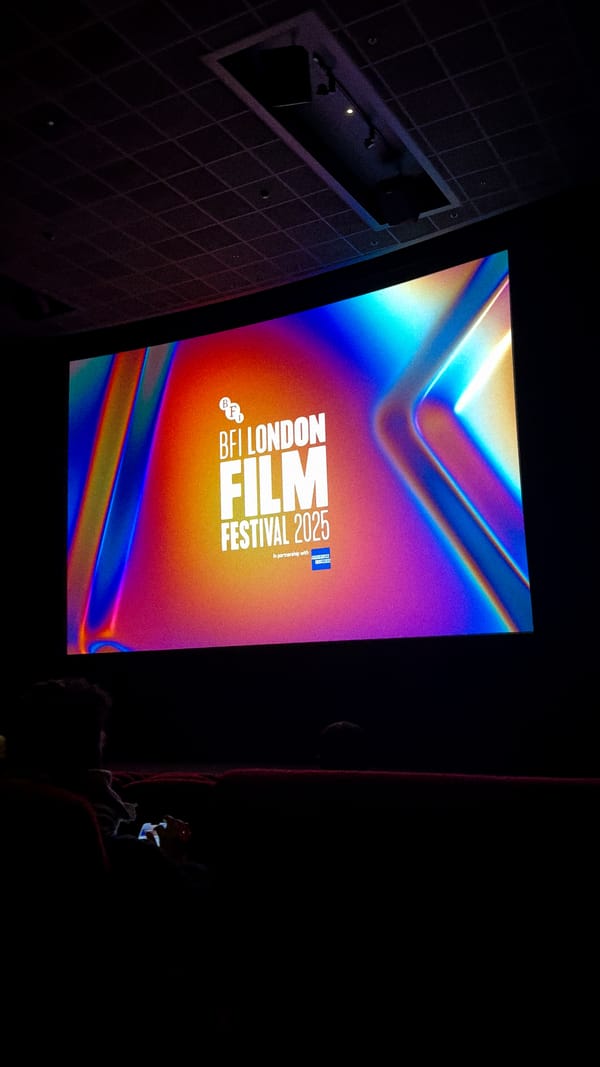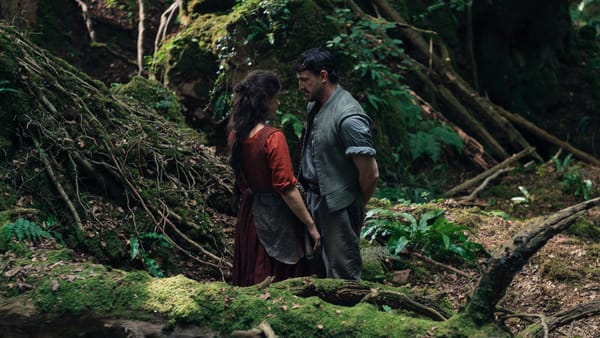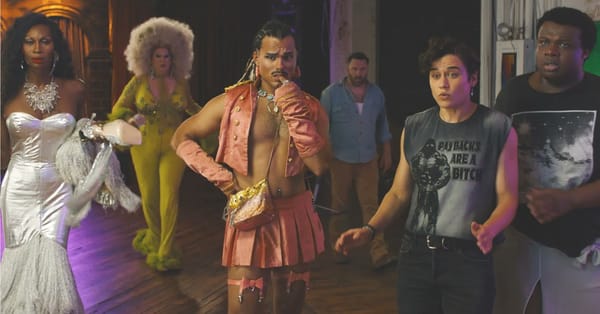The state of Lesbian Feminist Filmmaking today: An Interview with Fleur Bardot and Megan Teo
This Pride Month, our newest contributor, Kerrie Draghi, shares a piece from 2024 when she sat down with Feminist Filmmaker Fleur Bardot and Queer Producer Megan Teo about their short, "Arpeggio", and the importance of platforming authentic voices when telling Lesbian stories.

According to a 2020 survey conducted by the LGBTQ charity GLAAD, lesbian representation in films has decreased significantly - down from 36 percent as compared to 55 percent in 2018. From my own experience watching a lot of TV and films, I have found that gay men are featured in popular TV shows and movies, often as a flamboyant sidekick to the heterosexual female protagonist. While this is obviously not representative of all gay men, it is rare to find any similar positive representation of queer women on screen.
I can count on the one hand the well-known films that center lesbians: A Portrait of a Lady on Fire (2019), But I’m a Cheerleader (1999) and Blue is the Warmest Colour (2013). The last is a controversial mention as the author of the graphic novel that the movie is based on, and the lead actresses have since said that they found the film’s sex scenes to be unrealistic and exploitative.
However, that doesn’t mean that there aren’t any interesting representations of queer women on screen. In recent years, we have had Booksmart (2019), Bottoms (2023) and the recently released Love Lies Bleeding (2024) produced by A24.
In a world where all the new Hollywood movies seem to be revivals of classics, such as the recently released Beetlejuice, Ghostbusters and Mean Girls sequels to name just a few, one cannot help but wonder - wouldn’t it make more sense for the big-name movie companies to start investing in original and socially relevant independent films instead? Films that already have prestige and loyal fanbases are likely to sell, but it is long past time that mainstream cinema reflected the experiences and lives of queer women.
In 1975, the feminist film theorist Laura Mulvey talked of the male and female gaze in cinema. The male gaze is a now-popular term to describe the ways that women are portrayed in oversexualized in unrealistic ways on screen, to appeal to men. The female gaze has been discussed recently and used to describe the works of female artists and filmmakers such as Sofia Coppola, but it can still be difficult to understand and point out. As people living in a patriarchal society, it is hard for us to imagine how we would act if we never had to think about how men perceive us.
I won’t pretend that more positive and realistic portrayals of queer women in popular movies will fix everything, but it is hard to deny how the media we consume influences our perceptions of the world and people in it.
On last year’s Lesbian Visibility Day, I was in the parking lot of University of Arts London surrounded by other queer women in a protest scene for a short lesbian-feminist film called Arpeggio. We were all asked to dress in ‘grunge’ style, so we were wearing leather jackets, boots, fleeces and political badges. Around us were painted protest signs with phrases like “Abolish the male patriarchy”, “Dykes Unite” and “Women lover.” One crew member was handing out purple bandanas for us to wear that she had made herself, printed with the Venus symbol, ‘Dyke’ and ‘Lesbians Unite.’
It shouldn’t be, but those two words still feel radical to use in how they identify you as a woman choosing to center women in her life, over men.
I had been asked by director and UAL student Fleur Bardot to join in because she wanted as many ‘real life’ feminists/queer women as possible to be in the film and keep it true to reality. Most of the people working on the film are queer women, and all are feminists, Fleur tells me.
Her film is called Arpeggio and tells the story of a 30-year-old female pianist called Julie who reminisces about her past relationship with another woman, Sara, as she composes a piece of music for her, as her audition into a Masters’ program in Music Composition.
As Julie writes her composition, we are taken back a decade to the time of their romance in the 2010s. Julie is an anxious, introverted and solitary student whilst Sara is a passionate, extroverted and radical poet. Some of its’ influences are A Portrait of a Lady on Fire (2019) and The Piano (1993). The film takes place in the present and in Julie’s memories.
The film’s director, Fleur Bardot is an up-and-coming feminist director from France. Studying Film Practice at the University of the Arts London, her work is defined by its bold queer and feminist themes. In her works and in this short film, she hopes to reshape the representation of women’s stories through the art of filmmaking.
Megan Teo, the film’s producer is a Singaporean based in London. Their work aims to collaborate with new directors with unique voices and narratives. They've produced several short films, such as ‘Millennium Tides’ which was premiered online by School of the Arts Singapore, and ‘Seeking Sal’ a sci-fi podcast which was nominated at International HEAR NOW Festival and the New Cinema Film and Music Festival.

Interview
Kerrie: Hey Fleur and Megan! Thanks for meeting with me. In your own words, why is it important to make a film like this and tell stories about queer women from a feminist perspective?
Fleur: The representation of queer women in films has been very misrepresented and oversexualized. Blue Is the Warmest Colour is 70% sex scenes. Male directors seem to direct these films to expand on their own sexual fantasies of women loving women. That is not our story at all. And that is why our voices need to be heard.
In Arpeggio, we are focusing on the narrative of two queer women in the 2010s and in that timeframe, things were starting to emerge politically for lesbians, but we were not there yet. One of our characters, Sarah, is out and proud whereas Julie is not, and her family is a lot more hostile. The question of whether someone will be in or out of the closet is very much still present in our lives.
Megan: The point where we are now is a kind of resurgence of lesbian films, made by and for us, with films like Love Lies Bleeding and Bottoms. Previously, those films were very much from the male gaze. You can definitely tell the difference.
Kerrie: How do you define the female gaze, and use it in this film?
Fleur: For me, the female gaze is following the journey of a woman who is a protagonist in the film through her narrative and eyes. In Arpeggio, we feel, see and hear what she feels. We are on her level, with no dominance.
Often in a film, when we see a woman for the first time, the shot goes from the feet and up to the face, lingering on the breasts. She is nothing. Just a body.
Kerrie: We were talking earlier about the theme of dominance in the representations of lesbian relationships on film. Can you expand on this?
Fleur: In a lot of these films, one of the two women in the relationship will dominate the other. And that is so wrong to me. There should be no imbalance of power in queer couples because we are the same in our gender. Dominance can happen everywhere and with queer couples, of course. But it is not the representation I want.
Megan: Respectfully, I think that is what happens when men are directing our stories. You can see it and you can feel it. That is why it is so essential that we empower female filmmakers, especially queer, to tell our stories. One of the things I really love about working with Fleur and the scripts is that it never centers men. With our specific feminist lense, it shows how it is possible to eventually decenter men enough in your life and narrative. And it feels disruptive to try to force a man into that story.
Fleur: One of the things we are trying to say with our films is that women can live a life without men. A lot of women generally have been harmed by men in our personal lives. We have been silenced and crushed by them. So, no way in hell will I ever give a man a piece of very key dialogue in a script and embellish their presence in my films.
Kerrie: What are your hopes for what audience members will gain from watching this film?
Fleur: When I write films and direct them, I want people to come out of them with answers and questions. The energy to move things and shake things up. At least, teach someone a lesson. I don’t want people to be passive when they watch one of my films. It is also for queer people who resonate with our story and relate to that. Something that people can connect to.
Megan: The dream and key are to bring people together and spark a dialogue with film, even if it is a small one. That is the nature of queer feminist filmmaking. Each is a little piece of a puzzle coming together and if someone resonates with that one piece, it’s amazing.
Kerrie: Finally, why the title Arpeggio?
Fleur: An Arpeggio is a sequence of cords that ascend and descend. Throughout the script, there are ups and downs in every scene, setting or character dynamic, and more globally. It is a constant fluctuation of emotions that go up and down, like the musical notes. It is also up to the audience to say whether the film’s ending is a good or bad one. In its message of politics and hope, it is constantly an uprising.






